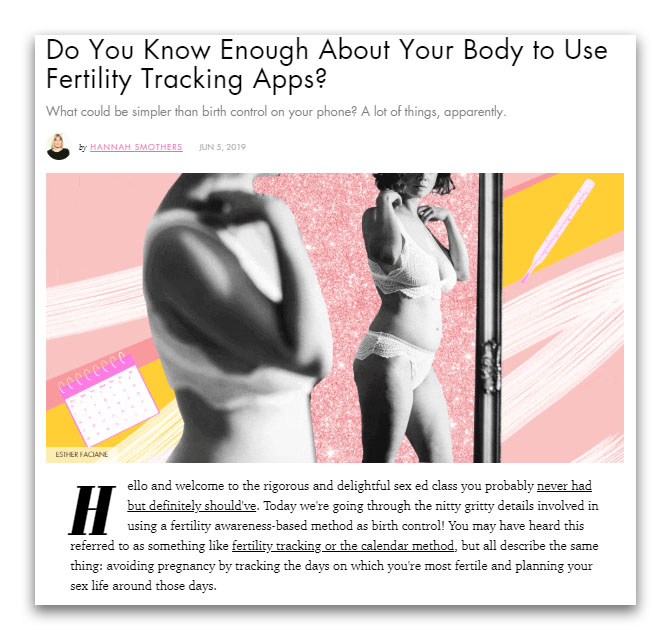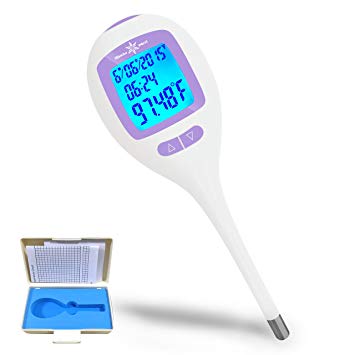
Yesterday, Cosmopolitan published an article titled ‘Do You Know Enough About Your Body To Use Fertility Tracking Apps?’ Unfortunately, the article was packed full of misinformation and displayed an astounding lack of understanding about how Fertility Awareness-Based Methods (and our bodies) actually work. Luckily for me, I see these types of articles so frequently that I no longer have a heart attack when I read them; however, it is of huge (huge!) concern that readers may subsequently make choices about their reproductive healthcare based on inaccurate information.
These days, I really do have to wonder why the writers behind these articles never think to contact a qualified Fertility Awareness professional to speak to a credible source before they press ‘publish’.
Anyway, without further ado – let’s count all the ways that Cosmo got it wrong (like – really, really wrong).
[In regards to Fertility Awareness-Based Methods] ‘You may have heard this referred to as something like fertility tracking or the calendar method, but all describe the same thing: avoiding pregnancy by tracking the days on which you’re most fertile and planning your sex life around those days’.
Actually no, they don’t all describe the same thing. The Rhythm Method involves counting days of past cycles to make predictions about when you will be fertile in future cycles. This is problematic because there are many things that can cause our cycles to change each month. For this reason, the Rhythm Method has a very high failure rate and is not suitable for anyone who genuinely wants to avoid pregnancy. Thankfully, Symptothermal Methods involve zero predictions. Instead, they track cervical fluid and basal body temperature on a day-by-day basis so that you know whether or not you are fertile on any given day. Symptothermal Double-Check Methods are an exception to this – they actually incorporate a calculation (based on past cycles) as to when a user might first expect to see cervical fluid after menstruation. This calculation allows users to double check the opening of the fertile window (instead of just relying on cervical mucus). While calculation rules are indeed predictions, they act to make the method more conservative and are always overriden by actual physical observations. You can read more about the different types of FABMs by clicking here.

‘”A healthy menstrual cycle is 28 days”, Dr Nate DeNicola, MD, an ob-gyn in Washington D.C. says’.
A healthy menstrual cycle can actually range from around 24 – 38 days. In fact, only around 1 in 10 women consistently experience a menstrual cycle of 28 days in length.
‘”If your cycle’s not at least somewhat regular, then this probably isn’t going to work well for you because the chance of predicting the fertile window to avoid is pretty low” Dr DeNicola says’.
Remember the bit above where we clarify that the Symptothermal Method doesn’t involve predicting fertile days? It doesn’t matter how irregular your cycle is, you can still track your cervical fluid and basal body temperature to know whether or not you are fertile on any given day. For those with extremely long cycles the same applies; however, it may mean you experience long periods of needing to use barrier protection such as condoms or a diaphragm (as opposed to the shorter fertile window in a normal length menstrual cycle).
“The chance of getting pregnant while solely using fertility awareness is 25 percent”
This statement is so problematic I don’t even know where to begin!
It seems that Cosmo is perhaps using older figures from the US National Survey of Family Growth which showed an overarching 24% failure rate for all different types of Fertility Awareness-Based Methods. The US NSFG report was careful to note however, that over 80% of respondents to their survey were using the Rhythm Method. This means that the results don’t really tell us anything useful about the Symptothermal Method. For more information on effectiveness rates, I highly recommend visiting this fantastic blog by Dr. Chelsea Polis who is a reproductive health epidemiologist with the Guttmacher Institute: http://chelseapolis.com/blog/understanding-effectiveness-estimates-for-fertility-awareness-based-methods-of-contraception
Currently, the CDC states that there is a 2 – 23% chance of pregnancy with typical use of fertility awareness – but this depends on which method you use. The 2% failure rate is based on a 2007 study of the Sensiplan method, which is a Symptothermal Double-Check Method (if you remember previously, Symptothermal Double-Check Methods are a little more conservative than Symptothermal Single-Check Methods due to the inclusion of calculation rules to double-check the opening of the fertile window). The 2007 study was based on the results of following 900 women over the course of 17,638 menstrual cycles. These women were working very closely with Sensiplan instructors and were found to have a 1.8% typical use failure rate, and a 0.4% perfect use failure rate.
When discussing effectiveness rates of FABMs, we currently don’t have a large and robust pool of evidence to draw from. Moderate quality studies tell us that the Sensiplan method has shown a 0.4% perfect use failure rate. This is very promising! When it comes to typical use however, we really need larger retrospective population-based surveys to give us a wider range of demographics and a more accurate estimate of real-world experiences. While we have a typical use estimate of 1.8% for the Sensiplan method, this estimate is based on a prospective clinical trial which isn’t as well suited to delivering typical use rates. It’s also based on users who were working very closely with an instructor – not those who were self-taught.
Unfortunately, the user-base of FABMs doesn’t really provide large enough populations to study for accurate typical use rates of individual methods. Additionally, there isn’t much incentive for these studies to be carried out considering there’s no pharmaceutical company behind the scenes waiting to profit from a new drug. I often wonder who’s going to be willing to fund further studies on FABMs!
The main takeaway here is that the discussion around FABM failure rates is highly nuanced and hasn’t been done justice by Cosmo.
“Ovulation, or the fertile window, is usually described as a five day window” [Dr DeNicola]’
Contrary to this, most studies actually show us that the biological fertile window is around six days. Five days leading up to ovulation, and the day of ovulation itself.
‘The basal body temperature can be measured orally, vaginally, or anally with an accurate thermometer that measures in tenths of degrees’.
This is a pretty big inaccuracy. Basal body temperature thermometers need to measure to two decimal places to be used with the Symptothermal Method – this is absolutely critical to ensure you’re picking up on the small shifts that occur after ovulation. If your thermometer only measures to the nearest tenth of a degree (that’s one decimal place) then it is not sensitive enough to be used for your charting practice. On top of this, while basal body temperature can be measured anally, I don’t know of a single person I’ve ever encountered who has done so. Most of us happily take our temperature orally each morning. You can find a list of recommended basal body temperature thermometers here.

‘Dr DeNicola says it doesn’t so much matter what time of day you take your temperature, but that you should always take it at the same time of day (like you would a birth control pill, for example).’
Basal body temperature (BBT) is your lowest core body temperature at rest, and it actually occurs around 4:30am each day. This is because your body temperature changes in a circadian rhythm – that is, it’s lowest in the early hours of the morning, and highest in the afternoon. The Symptothermal Method requires that you take your waking temperature (slightly different from true BBT) after at least 3 consecutive hours of sleep and at the same time each morning (give or take around 30 minutes). It’s very unlikely that you are going to get an accurate chart by taking your temperature at other times of the day (say lunchtime, or late afternoon), unless you’re having at least 3 consecutive hours of sleep prior. In addition to this, all effectiveness studies on the Symptothermal Method involved participants who were measuring their early morning waking temperature.
[In regards to cervical mucus] ‘Yes, I know, this is gross. Dr. DeNicola knows it, too. But such are the wonders of the human body’.
Ok.. wow, thanks for telling your readers that their bodies and how they work are ‘gross’. Nice to know that a trusted medical professional (who actually looks at vulvas, vagina’s and cervixes all day) also thinks the same! This is classic body-shaming and an extension of menstrual taboo – where anything to do with our reproductive systems has to remain ‘hush-hush’ for fear of offending anyone. Heaven forbid we accept and celebrate the wonderful biology that allows the continuation of the human race! If you’re interested in checking out photos of real-life cervical fluid, click through to the cervical fluid gallery.

‘If you haven’t caught on by now, even the most highly regular of cycles can go haywire, making it extremely difficult (if not impossible) to accurately guess when you’re ovulating, 100 percent of the time.’
Thankfully, none of us who use the Symptothermal Method are guessing as to when ovulation will occur! As mentioned above, the Rhythm Method (which is what most period tracker apps use) involves predicting and guessing when ovulation will occur. This makes it prone to a scarily high failure rate. The Symptothermal Method on the other hand, involves zero guesses or predictions – just checking in daily with your cervical fluid and basal body temperature to know whether or not you’re fertile – today.
‘If a fertility awareness-based method is something you’re truly interested in, Dr DeNicola urges you to please bring it up with your doctor. A good doc won’t ever shame your choices, even the ones that are statistically not great at preventing pregnancy.’
There are two parts I would like to break down here. First off, a doctor is actually not the best person to speak with if you’re interested in using a Fertility Awareness-Based Method. Why? Because most doctors receive little to no training on FABMs – at best they might hope for perhaps a pithy one-hour lecture. And as you can see from Dr DeNicola’s comments, it’s clear that this training was definitely not thorough enough. In fact, in a 2011 survey of United States Obstetrician-Gynaecologist physicians, 68% considered FABMs to be a poor option for most women. But when they were asked to estimate typical use effectiveness rates, the average answer given by these physicians was that 25% of couples practising a FABM would fall pregnant within a single year! This displays a clear lack of education about the different types of FABMs and their true effectiveness rates – and it is this lack of education which ultimately affects patients who have their earnest questions effectively ‘pooh-poohed’ and brushed aside.
Secondly, as we discussed prior, the discussion around effectiveness rates is complex. However, the Sensiplan Symptothermal Double-Check Method has been proven up to 99.6% effective with perfect use. To say that this method is ‘statistically not great at preventing pregnancy’ is factually inaccurate and exhibits a clear and disturbing bias against natural forms of contraception.
So while I’m not surprised to read this recent article from Cosmopolitan, I’m certainly disappointed. Once again, the general public is left with inaccurate, incomplete and biased information to sift through when it comes to making decisions about Fertility Awareness-Based Methods.
Did you have to wade through misinformation when you were looking into using the Symptothermal Method? I’d love to hear your experiences in the comments section below!

